Given numerous variables when selecting an aeration blower system for wastewater applications, and equally numerous claims by technology providers, it is not surprising that confusion exists. Worse than confusion is the disappointment that results when a blower technology fails to perform as anticipated—and operating costand efficiency benefits go unrealized.
This guide explains three blower technologies and,using examples from actual wastewater plants, describes the most effective technology for particular applications and why. Of course there is no substitute for a consultation specific to your application; however, the guide can help raise the right questions and ensure a productive vendor and technology evaluation process.
Introduction
Energy consumption and cost have been the key drivers behind the development of more efficient aeration blower systems. These systems can account for as much as 60 percent of the total energy consumption of a wastewater treatment plant (WWTP). Therefore, the payback on greater energy efficiency is significant.
Technological advancements in aeration blowers are providing new options for reducing energy consumption. However, these options also require greater understanding of the overall system and fluctuations in operating conditions in order to optimize the total cost of ownership and maximize return on investment. If the choice of an aeration blower was simply based on the energy efficiency or initial cost of the technology — irrespective of the operating conditions — it would be easy to select the most effective aeration blower. However, once installed, the cost-benefit intended is not likely to be achieved if the technology is misapplied.
An accurate cost-benefit analysis must include the capital expenditure of the aeration blowers themselves, and the operating variables. Consider daily and seasonal swings in oxygen demand, fouling and aging of diffusers, air flow control and turndown capabilities, total blower efficiency and energy consumption over time, mode of operation, blower accessories, and plant set up when making your decision.
Operating variables can significantly affect cost and benefit. With energy efficiency the primary driver of aeration blower technology, the goal of this paper is to illustrate the most efficient and cost-effective way to achieve energy efficiency based on real-world applications and right-sizing blower technologies.
An Overview Of Current Blower Technologies
There are four main blower solutions for wastewater aeration applications: positive displacement blowers, turbo blowers, hybrid blowers, and combination blower technologies. The following sections provide brief introductions to these approaches and outline the benefits and limitations of each.
Positive Displacement (PD) Blowers
These blowers are defined as rotary lobe blowers with straight or twisted lobe rotors without internal compression. Often, they are referred to as "the workhorse" for its flexibility to perform well despite changing conditions, the PD blower has a lower initial cost than its turbo and hybrid counterparts. However, the PD blower's lower cost can be offset by higher energy consumption, depending upon the operating conditions. When it comes to turndown, PD far exceeds turbo blower technology by achieving ratios as high as 4:1.
PD Basic Design Principles
- Constant volume against varying pressure
- Flow changes by varying speed with variable frequency drive (VFD)
- Large turndown (typically 4:1)
- Adapts naturally to changes in pressure and temperature
- Widely used
- Low initial cost
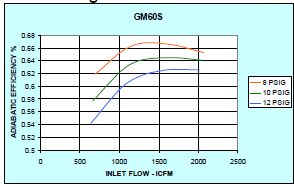
PD Limitations
- Slip between rotors increases with differential pressure
- Efficiency drops at lower speed
- Efficiency drops at higher pressure

Click here to enlarge
Turbo Blowers
When operating near its design point, the turbo technology may be the most efficient and therfore performs cost-effectively in applications with narrow swings in turndown. Turbo has a higher initial cost than its rotary lobe and hybrid counterparts. However, in applications with less variation in operating conditions, the additional cost can be compensated for in lower energy consumption.
Centrifugal Design Principles
- Dynamic compression
- “Sweet zone” of highest efficiency
- Must operate on performance map
- Flow too low or pressure too high = surge
- Flow too high or pressure too low = choke
- Performance varies with air density
- Summer (high loads, low air density)
- Winter (low loads, high density)
Turbo Blower Advantages
- Higher efficiency than conventional rotary lobe technology
- Small footprint reduces cost to design new and retrofit blower rooms
- Integrated package including blower, motor, and controllers makes installation easier
Turbo Blower Limitations
- Limited operational range relative to pressure and airflow (typically 2:1 turndown)
- Limited on/off cycling due to airfoil bearing limits, and limited wear on electronic components
Hybrid (Rotary Screw Compressors) Blowers
This technology provides energy efficiency comparable to turbo and the flexibility of PD technology. The hybrid uses a low-pressure screw rotor instead of a straight or twisted rotary lobe rotor. In applications with large swings in flow and pressure, hybrid blowers can achieve rates as low as 25 percent of the original design point.
Hybrid Design Principles
- Constant volume against varying pressure
- Large turndown (typically 4:1)
- Flow changes by varying speed (VFD)
- Rotors mesh, compressing air inside housing
Hybrid Advantages
- Comparable efficiency to turbo
- High efficiency throughout range
- Tolerant of variations in pressure
Hybrid Limitations
- Less efficient at very low pressure than rotary lobe blowers
- Higher capital cost (10% higher than PD)
- Larger footprint than turbo
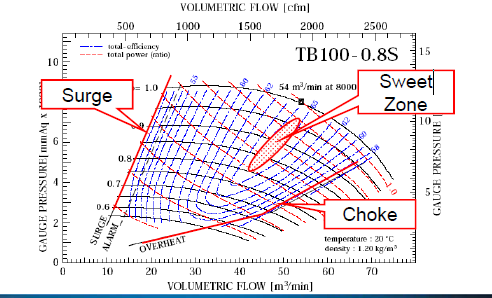
Combination Blower Technologies
For large WWTPs, applying a combination of blower technologies at various points in the treatment process can improve overall energy efficiency and reduce initial and long term operating costs. This solution can be especially effective in a retrofit application and in processes where the duty cycle on the blower can be as low as running only one hour per day.
- Turbo blowers are ideal for applications wherethey can run at the same speed all day—theyare less efficient when used in applications with regular fluctuations. The best way to optimize asystem is to combine a turbo (for base load) with a hybrid (for peak loadand low flow conditions).
- It is critical that the turbo is able to tolerate the introduction of the hybrid without surging. The idling feature and the current-based inverter control easily facilitate this combination.
- It is also critical that the PD or hybrid be equipped with pulsation attenuation, to minimize the disturbances in the system while operating with the turbo.
- Overall energy efficiency can be higher with this approach, and the overall turndown range can be extended to 6:1 or more.
WWTP Application Examples
The following case studies illustrate results that can be achieved by implementing turbo, hybrid, and combination blower technologies in WWTPs.
Turbo Blower: Blue River WWTP
Overview: Built in 1974, the Blue River Wastewater Treatment Plant in Silverthorne, Colo., provides wastewater services to the communities of Silverthorne, Dillon, Dillon Valley, Buffalo Mountain, and Mesa Cortina. A conventional activated sludge plant with extended aeration capabilities and a design capacity of 4 million gallons per day (MGD), the Blue River WWTP serves resort communities with high variation in usage, both seasonally and between midweek and weekends during the peak season.
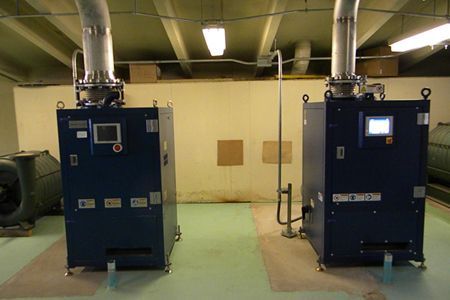
Aerzen TB100 turbo blowers at the Blue RiverWastewater Treatment Plant (Silverthorne, Colorado)
Average demand ranges from approximately 1.5 to 2 MGD. Given the variation in basin levels and the limitations on turndown in the multistage centrifugal blowers, the plant operators were frequently over-aerating, resulting in energy loss and lowered overall blower efficiencies. Engineers experimented with adding VFDs to the old blowers to reduce energy consumption, but it proved difficult to protect the centrifugal blowers from surge.
Objective: Reduce rising energy costs and replace the aging multistage centrifugal blowers with new technology that would reduce energy consumption and provide steady and reliable operation.
Results: The Silverthorne-Dillon Joint Sewer Authority (JSA) selected the Aerzen TB100, a 100-horsepower turbo blower for its ability to meet the plant's maximum design aeration requirements of 1,400 cubic feet per minute (CFM) at a pressure of 7.5 psi. The TB 100 runs on a permanent magnet motor specifically designed for the high frequency and high speed requirements of a direct drive turbo application.
An immediately apparent benefit was the drastic reduction in noise, eliminating the need for hearing protection. The plant has averaged 20 percent greater energy efficiency than with its predecessor blowers, which translates to annual savings of approximately \$6,500. Another energy benefit is the heat recovery from the blower's cooling system. The warm air is used to heat the facility during the cold winter months, and a separate cooling air connection vents the heat outdoors during the summer months. Since the blowers use airfoil bearings that are lubricated by air instead of oil, the plant has also reduced its maintenance costs.
Hybrid Blower: City Of Anacortes WWTP
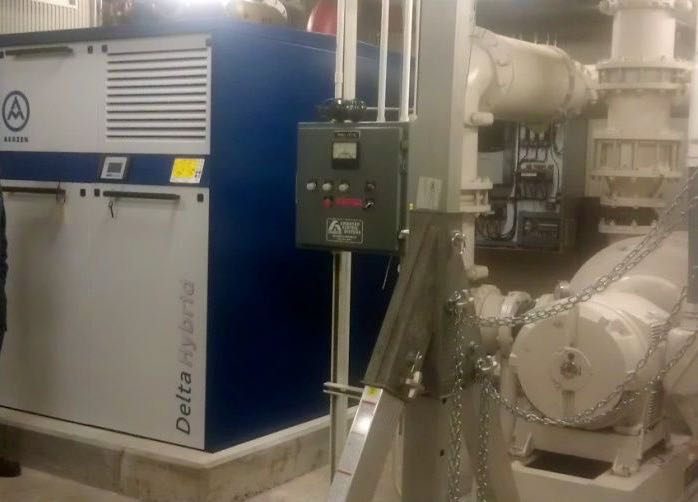
The City of Anacortes replaced a 125HP multistage centrifugal blower (right) with an Aerzen D 62S 75HP hybrid blower (left).
Overview: The City of Anacortes WWTP is located in the state of Washington off the coast of Puget Sound, which is home to a variety of wildlife and aquatic life. Its WWTP processes 2 MGD and was using three 150 hp multistage centrifugal blowers with a minimal air flow rate of ~1750 standard cubic feet per minute (SCFM) — far more than required to maintain adequate dissolved oxygen (DO) in the basin.
Objective: Improve efficiency of the aeration system and reduce operating costs and energy consumption/costs by investing in more efficient blower technology.
Results: After evaluating hybrid and turbo technologies, the plant selected the Aerzen Delta Hybrid model D 62S with a 75 hp motor for two reasons: 1) lower initial and operating costs and 2) broad range of operating conditions, specifically greater turndown capacity. The new Delta Hybrid operates between 1,450 SCFM at peak flow and 600 SCFM during the night, for a power savings of 30 to 55kW.hr, depending on the time of day.
The new blower also enabled the plant to turn off two channel air blowers, which alone saved ~\$11,700/year. All told, the new aeration system saved the city ~\$56,155/year in energy costs and demand fees, which their utility provider charges industrial customers based on consumption. Payback was achieved in 22 months. In addition, the plant was able to use existing maintenance staff to service the new aeration blowers, eliminating the potential costs associated with service and maintenance agreements.

The City of Anacortes experienced a significant decrease in energy use with the Aerzen Delta Hybrid blower.
Click here to enlarge
Combination Blower Technology: Bremervörde Sewage Treatment Plant
Overview: The Bremervörde sewage treatment plant in Germany has an overall design capacity of 30,000 Einwohnergleichwert (EGW, or population equivalents) — a measurement of the total pollution load divided by the individual pollution load of one person. Operating at approximately 29,000 EGW, the plant is nearing full capacity, processing up to 3,000 cubic meters of wastewater per day. However, weekend turndown can result in load fluctuation from 1,200 to 1,500 cubic meters. During the week, the plant processes a nearly constant 1,500 cubic meters per day using two existing Aerzen Delta PD blowers. Approximately 75 percent of the plant's energy consumption goes toward generating process air, which represented a significant operating cost reduction opportunity.
Objective: Optimize energy use by implementing a fully automated blower system that would meet process air requirements within the operating range of 50 to 100 percent.
Results: The plant selected the Aerzen AT 100 turbo blower. The new turbo blower serves as a base load generator for process air, operating at a capacity range from 35 to 80 cubic meters per minute (1200 to 2800 SCFM). The two existing PD blowers are connected to the new system and automatically start when needed to handle peak loads or serve as redundant blowers. Adding the new turbo blower resulted in cost savings on the order of 20% to 25%.
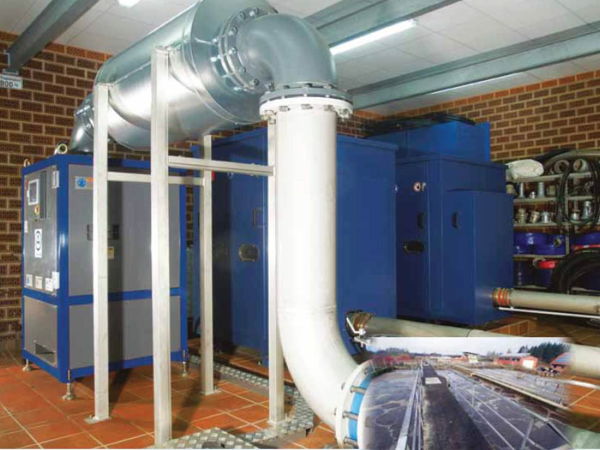
Aerzen AT turbo blower and two PD blowersprocessing air at a Bremervörde, Germany WWTP.
Summary And Conclusion
WWTP plant managers have more opportunities to optimize energy efficiency and reduce operating costs thanks to a variety of aeration blower technologies and application concepts. A thorough understanding of the overall process, operating conditions, and interplay of aeration and process controls is key to a successful implementation.
Often, technologies are misapplied due the promise of high energy efficiency, failing to consider operational variables that will ultimately cause the machine to run outside its intended range. New concepts of applying established and more recent technological advances within the context of the entire WWTP system have proven effective in maximizing the benefit of each technology. The result is an improvement in the overall operating efficiency of the WWTP in terms of overall equipment effectiveness (OEE), energy efficiency, and reduced operating and maintenance costs.
Learn how your plant can optimize energy efficiency and operating effectiveness with Aerzen's An Engineer's Mini Guide to Blower Technology Selection or contact your local Aerzen application specialist to discuss your application today Tel. (610) 380-0244.
For more information contact Tom McCurdy, Regional Sales Manager, Aerzen USA, or visit www.aerzenusa.com.
To read more Blower Technology articles please visit www.blowervacuumbestpractices.com/technology/blowers.



